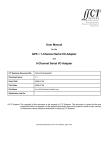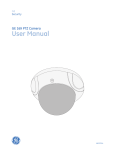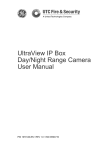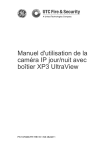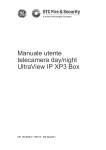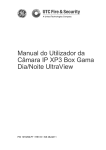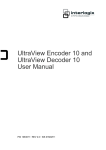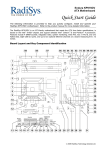Download TruVision NVR 40 User Manual - Ber
Transcript
GE Security TruVision NVR 40 User Manual P/N 1069162 • REV 1.0 • 13OCT09 Copyright © 2009 GE Security, Inc. This document may not be copied in whole or in part or otherwise reproduced without prior written consent from GE Security, Inc., except where specifically permitted under U.S. and international copyright law. Disclaimer The information in this document is subject to change without notice. GE Security, Inc. (“GE Security”) assumes no responsibility for inaccuracies or omissions and specifically disclaims any liabilities, losses, or risks, personal or otherwise, incurred as a consequence, directly or indirectly, of the use or application of any of the contents of this document. For the latest documentation, contact your local supplier or visit us online at www.gesecurity.com. This publication may contain examples of screen captures and reports used in daily operations. Examples may include fictitious names of individuals and companies. Any similarity to names and addresses of actual businesses or persons is entirely coincidental. Trademarks and patents GE and the GE monogram are registered trademarks of General Electric Company. The TruVision NVR 40 name and logo are trademarks of GE Security. Other trade names used in this document may be trademarks or registered trademarks of the manufacturers or vendors of the respective products. Intended use FCC compliance Use this product only for the purpose it was designed for; refer to the data sheet and user documentation for details. For the latest product information, contact your local supplier or visit us online at www.gesecurity.com. This equipment has been tested and found to comply with the limits for a Class A digital device, pursuant to part 15 of the FCC Rules. These limits are designed to provide reasonable protection against harmful interference when the equipment is operated in a commercial environment. This equipment generates, uses, and can radiate radio frequency energy and, if not installed and used in accordance with the instruction manual, may cause harmful interference to radio communications. You are cautioned that any changes or modifications not expressly approved by the party responsible for compliance could void the user's authority to operate the equipment. Certification and compliance Regulatory European Union directives TruVision NVR 40 complies with following regulations: - UL60950, EN60950 - CFR47 Part15B class A, EN55022 class A, CISPR class A - EN50130-4 2002/96/EC (WEEE directive): Products marked with this symbol cannot be disposed of as unsorted municipal waste in the European Union. For proper recycling, return this product to your local supplier upon the purchase of equivalent new equipment, or dispose of it at designated collection points. For more information see: www.recyclethis.info. 2004/108/EC (EMC directive): Non-European manufacturers must designate an authorized representative in the Community. 2006/66/EC (battery directive): This product contains a battery that cannot be disposed of as unsorted municipal waste in the European Union. See the product documentation for specific battery information. The battery is marked with this symbol, which may include lettering to indicate cadmium (Cd), lead (Pb), or mercury (Hg). For proper recycling, return the battery to your supplier or to a designated collection point. For more information see: www.recyclethis.info. Contact information For contact information see our Web site: www.gesecurity.com. For contact information see our Web site: www.gesecurity.eu. Content Preface 3 Safety guidelines 4 Safe handling 4 Safety 4 Rack system safety precautions 4 Removing the battery on the motherboard 5 TruVision NVR 40 unit overview 6 Package content 6 System requirements 6 Software requirements 7 Other requirements 7 Before you begin 7 References and related documentation 7 TruVision NVR 40 network video recorder 7 Interface module 9 Storage 9 Hardware installation 11 Packing contents 11 Installation procedure 11 Rack-mounting the unit 12 Connecting the power supply 12 Connecting the TruVision NVR 40 13 Front panel connectors 13 Interface module connectors 13 Basic setup 14 Front panel LEDs 15 Starting and configuring the TruVision NVR 40 16 Turn on the unit 16 Installing on a network 16 Access the embedded web server 16 Monitoring of TruVision NVR 40 18 Access and configure TruVision NVR 40 21 Restart the TruVision NVR 40 27 Maintenance 28 Battery removal/disposal 28 Replacing fans 29 TruVision NVR 40 User Manual i Glossary 30 Contacting technical support 31 Online resources 31 Technical specifications 33 Dimensions 33 Weight 33 AC power module (1 x 300W PSU) 33 Standards and regulations 34 International standards 34 Potential for radio frequency interference 34 European regulations 34 ESD precautions 35 Safety compliance 35 EMC compliance 35 AC power cords 35 ii TruVision NVR 40 User Manual Preface What is in this guide This manual contains specific procedures for the initial hardware installation, and procedures for performing the basic system configuration of your TruVision NVR 40 unit. Audience Setting up and maintaining a network requires the knowledge and expertise of people with a variety of skills. In many cases, the people responsible for installing hardware and wiring are not the ones who configure the software and administer the network; therefore, this publication provides information specific to installing the hardware and performing a basic system configuration. To use this publication, you should be familiar with electronic circuitry and wiring practices, and basic network configuration, and preferably have experience as an electronic or electromechanical technician. Related documentation • TruVision NVR 40 quick start guide • VOS 4.2.1 IP camera integration user manual • CCS 4.2.1 user manual or GE-NAV 3.0 user manual TruVision NVR 40 User Manual 3 Safety guidelines Safety guidelines Safe handling Permanently unplug the unit if you think that it has become damaged and before you move it. WARNING: • A fully assembled TruVision NVR 40 unit can weigh up to 18 kg (40 lb.). Be careful when lifting it by yourself. Safety • The TruVision NVR 40 unit must only be operated from a power supply input voltage range of 100 to 240 VAC, 50 to 60 Hz. • The plug on the power supply cord is used as the main disconnect device. Ensure that the socket outlets are located near the equipment and are easily accessible. • A safe electrical earth connection must be provided to the power cord. Check the grounding of the unit before applying power. • Provide a suitable power source with electrical overload protection to meet the requirements laid down in the technical specification. Equipment handling precautions Caution: The RJ45 sockets are for Ethernet connection only and must not be connected to a telecommunications network. Rack system safety precautions The following safety requirements must be considered when the unit is mounted in a rack. • The unit must be mounted in a 19” rack. • The rack construction must be capable of supporting the total weight of the installed unit(s) and the design should incorporate stabilizing features suitable to prevent the rack from tipping or being pushed over during installation or in normal use. • When loading a rack with the units, fill the rack from the bottom up and empty from the top down. WARNING: To avoid danger of the rack toppling over, do not slide more than one unit out of the rack at a time. 4 TruVision NVR 40 User Manual Safety guidelines • The rack design should take into consideration the maximum operating ambient temperature for the unit, which is 40°C (104°F). • The rack should have a safe electrical distribution system. It must provide overcurrent protection for the unit and must not be overloaded by the total number of units installed in the rack. When addressing these concerns consideration should be given to the electrical power consumption rating shown on the nameplate. • The electrical distribution system must provide a reliable earth for each unit and the rack. • The rack when configured with the units must meet the safety requirements of UL 60950-1 and IEC 60950-1. Removing the battery on the motherboard This product contains one CR2032-type single-use battery. When replacing the TruVision NVR 40, dispose of the battery as required by local ordinances or regulations. See “Battery removal/disposal” on page 28, for more information on the removal of the battery. TruVision NVR 40 User Manual 5 TruVision NVR 40 unit overview TruVision NVR 40 unit overview The TruVision NVR 40 (model number: TVN-40) is a network video recorder, capable of recording video from up to 12 or 24 IP cameras (depending on the specific model). For a full list of supported devices, refer to the IP camera compatibility list published by GE Security. TruVision NVR 40 storage unit is typically equipped as follows: • One processor motherboard, with associated memory and one 2.5’’ system disk. • Two or four SATA disks for storage (1 TB each) • One extension module: • RS-422/RS-485 serial communication and digital I/O Note: If you are using the device within a GE-NAV environment, go to the following site to get the latest version of the software: http://www.gesecurity.com/portal/site/GESecurity/menuitem.11620ebca5cc0a06574 efe10140041ca/?vgnextoid=d0b56e992c81e110VgnVCM100000592d7003RCRD If you are using the VisioWave/UltraView CCS or VSC software solution, refer to the appropriate CCS or VSC user manuals. Package content The TruVision NVR 40 package consists of the following: • One TruVision NVR 40 unit • One box with handles and screws • Two power cords (one for use in EU and the other one is North America) • One CD with TruVision NVR 40 user manuals • One CD with GE-NAV 3.0 application software • One quick start guide System requirements The TruVision NVR 40 is the storage part of an IP video security system, which includes: • One Video security application software: • • • • Storage device: • • GE-NAV 3.0 (or later) VSC 4.2.1 (or later) SDK-based application TruVision NVR 40 Video acquisition devices: TruVision NVR 40 User Manual 6 TruVision NVR 40 unit overview • • Ultraview UVE-101 (also know as Discovery-105E) Supported IP cameras (IP Cameras Integration Manual) Software requirements The TruVision NVR 40 software system consists of the following: • Embedded software: • • VOS version 4.2.1 (or later) Application software: • • GE-NAV 3.0 (or later) VisioWave Security Center version 4.2.1 (or later) Other requirements • Phillips M5 screwdriver Before you begin Inspect the package and contents for visible damage. If any components are damaged or missing, do not use the unit; contact the supplier immediately. If you need to return the unit, you must ship it in the original box. Refer to the “Site Preparation and Safety Guidelines” on page 5 for more information on safety measures necessary in order to perform any operation using the TruVision NVR 40. References and related documentation • Centralized Configuration Server user manual • VisioWave Security Center user manual TruVision NVR 40 network video recorder Figure 1: TruVision NVR 40 unit TruVision NVR 40 User Manual 7 TruVision NVR 40 unit overview Physical description The TruVision NVR 40 unit is a 2U high enclosure for 19’ rack mounting. TruVision NVR 40 front panel Figure 2: TruVision NVR 40 front panel The TruVision NVR 40 unit has all its connectors on the front panel. All functions are thus accessible via the front panel. This includes all interface modules, start button, and all the connectors. For an exhaustive list of connectors, see Figure 7 on page 13 and section “Front panel connectors” on page 13. There are also three LEDs to monitor the status of the main functions of the unit. See section Figure 10 on page 15 for more LED details. The unit has one handle on each side of the front panel to facilitate operations. These handles need to be installed. See section “Installing handles” on page 11. These two mounting handles on each side of the unit also make it possible to rackmount the chassis. See section “Rack-mounting the unit” on page 12. TruVision NVR 40 rear panel The rear panel of the TruVision NVR 40 only contains the fans and has no connectors. This design is user-friendly, because equipment is rack-mounted and therefore difficult to reach from the rear panel. Moreover, the cooling fans can directly pump air up through the rear panel that is covered by protective foam and expel the air via the front panel. Figure 3: TruVision NVR 40 rear panel See “Replacing fans” on page 29 for more information on replacing fans. 8 TruVision NVR 40 User Manual TruVision NVR 40 unit overview Interface module The interface modules provide additional low-cost, non-isolated serial communication ports and I/Os. Figure 4: Interface module Serial port The half/full duplex wiring selection is done by software, controlling both the H/F input pin of the transceiver that internally connects Tx and Rx as well as selective enabling for the receive and Transmit drivers. A switch enables the termination resistor. Rx and Tx resistors are activated independently. Terminations are enabled by default. Serial ports have been ESD protected. The differential drivers/receivers used (MAX3089E), offers the following characteristics: • • • • Fail safe Receiver RS-422/RS-485 electrical compatibility Enhanced electrostatic discharge protection Selectable between half and full duplex operation Transistor I/Os The 4 general-purpose inputs are pulled up to high level and trigger when the circuit is closed to the ground (active low). Inputs allow high level up to 48V. When an input is high, its respective LED is OFF. The LED is ON when the input is grounded. The 2 general outputs are open collectors (normally open). The maximum output current is 500mA and outputs are able to switch signal of up to 48V. Led is OFF when output is open. LED is ON when output is grounded (or closed). Storage The TruVision NVR 40 network video recorder provides embedded storage. The unit contains two or four SATA disks (storage capacity 1 TB each) for a total storage capacity of 2 or 4 TB (depending on the specific model). TruVision NVR 40 User Manual 9 TruVision NVR 40 unit overview Figure 5: RAID 0 mapping Features • • • Two or four serial ATA disks S.M.A.R.T disk drive monitoring for reliability System status indication through LED (front panel) and alarm software Note: Disks are configured and presented as single storage array to the user. 10 TruVision NVR 40 User Manual Hardware installation Hardware installation The TruVision NVR 40 Network Video Recorder comes with all applicable parts installed. The hardware installation procedure consists of mounting the unit in an appropriate 19’ rack. Package contents The following items should be included in the package: • • • • • • One TruVision NVR 40 unit One box with handles and screws Two power cords (one for use in EU and the other one in North America) One CD with TruVision NVR 40 user manuals One CD with GE-NAV 3.0 application software One quick start guide Installation procedure Caution: Make sure that the unit is turned off before proceeding. Installing handles 1. Lift the unit safely out of the packing container. As you unpack the unit, check for signs of shipping damage (damaged box, scratches, dents, etc.). If the unit is damaged or fails to meet specifications, notify the VisioWave support department or your local representative immediately. Also notify the carrier. Retain the shipping cartoon and packing material for inspection by the carrier. 2. Ensure the power service at the site is suitable for the unit you are installing. 3. Check the packing slip to ensure that all the proper components are present. 4. Open the accessories box. There are two handles and eight screws per unit. 5. Screw the handles to the chassis. There are four screws per handle. See Figure 6, item 2. TruVision NVR 40 User Manual 11 Hardware installation Figure 6: NVR 40 handles and screws for rack mount Rack-mounting the unit 1. Two handles for 19’ rack mounting are included with the unit. 2. Carefully align the unit with the rack and slide it into position, and then fix the unit to the rack with the screws provided. See Figure 6, item 1. WARNING: To prevent injury, grasp the unit underneath the lower edge, and lift with both hands. To prevent injury, keep your back straight and lift with your legs, not your back. Connecting the power supply 1. Connect the power cable to the power supply input, which is situated on the front of the unit. See Figure 9 on page 15. 2. Connect the opposite end of the power cable to an appropriate power source. The input power to the chassis is self-sensing and should be 110 ~ 230 V @ 50 ~ 60 Hz. Note: The socket-outlet should be installed near the unit and must be easily accessible. 12 TruVision NVR 40 User Manual Connecting the TruVision NVR 40 Connecting the TruVision NVR 40 Front panel connectors Figure 7: NVR 40 front panel connectors 1. Power socket 5. VGA 2. Interface module 6. LEDs 3. Keyboard and mouse 7. USB ports 4. Power button 8. Ethernet ports All connectors are located on the front panel of the chassis (see Figure 7 above). The NVR 40 unit contains the following connectors: • • • • • • • One keyboard connector (purple) and one mouse connector (green) Four high-speed USB 2.0 ports One VGA connector Two Ethernet ports (10/100/1000 Mbps) One On/Off button One power plug One interface module Interface module connectors The peripheral equipment can be connected either by using the front motherboard connector or the interface I/O or serial port modules. As far as the interface modules are concerned, pins are numbered from left to right when facing the interface module. TruVision NVR 40 User Manual 13 Connecting the TruVision NVR 40 Figure 8: The Interface module connector and pin position The detailed specifications for the module’s pins are shown in Table 1. Table 1: Module pin description Serial + I/O 485IO-UM-1 Signal Pin VCC5V 14 N/C 13 GND 12 RXD1 + 11 RXD1 - 10 TXD1 + 9 TXD1 - 8 GND 7 GPI2I 6 GPI22 5 GPI23 4 GPI24 3 GPO21 2 GPO22 1 Note: For GE-NAV, only the four alarm inputs are configurable. While for VSC and VisioWave, four alarm inputs, two outputs, and one RS-422/RS-485 are configurable. Basic setup To start the TruVision NVR 40 unit and connect to the network, follow this procedure: 1. Attach the power cord to the unit. See Figure 9, item 1 2. Attach the Ethernet cable to the Ethernet port. See Figure 9, item 2. 3. Press the power button on the front panel, to turn on the unit. See Figure 7. 4. The topmost LED on the front panel indicates whether AC mains power is present, constant green indicates when the power is on. See Figure 10 on page 15. 5. You are now ready to configure the TruVision NVR 40 through its Web server using a host computer. See Figure 11 on page 17. 14 TruVision NVR 40 User Manual Connecting the TruVision NVR 40 Figure 9: NVR 40 basic setup connections Front panel LEDs There are 3 different LED indicators on the front panel of the unit. Figure 10: Front panel LEDs Table 2: Front panel LEDs Icon LED Description Power status This LED indicates when the unit is turned on. Constant green indicates power on. Storage status/activity This LED monitors the status of the storage in the system. VOS (video operating system) identification LED This LED indicates when the embedded software (VisioWave Security Service) has detected an abnormal condition or a failure.* * In case of storage failure (LED is constant red), contact technical support. TruVision NVR 40 User Manual 15 Starting and configuring the TruVision NVR 40 Starting and configuring the TruVision NVR 40 This chapter describes the start up procedure and the necessary software configuration of the TruVision NVR 40 unit. Turn on the unit Turn on the unit (press the power button on the unit). See Figure 7 on page 13. The VisioWave video operating system (VOS) and the VisioWave Security Service software will then start up automatically. Configure the network parameters the first time the video equipment is switched on. See “Network configuration” on page 21. Otherwise the VisioWave Central Configuration server will not detect the unit and its input and output video channels on the net. Installing on a network The TruVision NVR 40 is installed on an Ethernet network. This involves assigning it an IP address, either manually or via an automated network service (DHCP). Depending on your network, select one of the following procedures: • • Automatic configuration using DHCP, see “Network configuration” on page 21. Manual configuration using fixed IP address, see “Network configuration” on page 21. Note: The TruVision NVR 40 has the default IP address 192.168.1.2 (Mask 255.255.0.0). DHCP is disabled by default. Monitoring system The monitoring system detects abnormal system operating conditions and generates alarm outputs or messages, allowing users to take necessary actions before system failure. The monitoring system can detect a wide variety of internal system conditions including temperature, voltage, fan operation, and power supply status. It can generate several different alarm outputs, including audible signals to notify nearby users or sending out alarm messages for remote notification. SNMP traps are also available. Access the embedded web server To access the unit via a Web server, use the default fixed IP address: 192.168.1.2 16 TruVision NVR 40 User Manual Starting and configuring the TruVision NVR 40 Figure 11 presents the homepage for the TruVision NVR 40, seen after connecting to the Web server. Figure 11: Embedded Web server homepage On the homepage menu, four options are available (these menu options are also available in other widows): • Home - return to homepage • Monitoring - used for monitoring the health of the unit • Administration - used for logon, network configuration, and setting/changing access rights. • Restart - used for restarting the device (for example, for changes to take effect) TruVision NVR 40 User Manual 17 Starting and configuring the TruVision NVR 40 Monitoring of TruVision NVR 40 Select the “Monitoring” option from the main menu to check: • • • • Health Metrics System Configuration Video Ports Network Interfaces Health Metrics The health metric window (see Figure 12 below) contains information about: • • • • • • • • CPU Temperature CPU Fan Speed Core Voltage +3.3 V +5 V + 12 V System Date & Time Uptime Figure 12: Health metric window 18 TruVision NVR 40 User Manual Starting and configuring the TruVision NVR 40 System Configuration The system configuration window (see Figure 13 below) contains information about: • • • Equipment name Serial number Software version Figure 13: System configuration monitoring window Video Ports The video ports window (see Figure 14 on page 20) contains information about: • • • • • • • • • • Slot number Port number Direction Label TCP Port Format Size FPS Bandwidth Status TruVision NVR 40 User Manual 19 Starting and configuring the TruVision NVR 40 Figure 14: Video ports window Network interfaces The network interfaces window (see Figure 15 on page 21) contains information about: • • • • • • • • 20 Connection Type IP/Mask Cable Status Rx/Tx Packets Rx/Tx Errors MAC Address Default Gateway Ethernet Configuration TruVision NVR 40 User Manual Starting and configuring the TruVision NVR 40 Figure 15: Network interfaces window Access and configure TruVision NVR 40 Select the “Administration” option in the main menu to access the Administration window. The default login is “admin” and the default password is “admin”. Four options in the administration menu are available: • • • • • Network configuration Manually set system date and time Change administrative password File firmware update Configuration download Network configuration To set the network configuration, follow the procedure below: 1. Connect to the NVR 40 unit using a Web server. Use the default IP address 192.168.1.2 (Mask 255.255.0.0). See “Access the embedded web server” on page 16. TruVision NVR 40 User Manual 21 Starting and configuring the TruVision NVR 40 Figure 16: Network configuration window 2. Access the device configuration window, by selecting Administration from the main menu and then Network Configuration icon. See Figure 16. 3. Select the Adapter name. 4. Select the mandatory options for network configuration: DHCP or Static IP • To set DHCP, select the DHCP Auto Configuration of IP Address box. DHCP is NOT set as default • To set static IP address, fill in the available fields: IP Address, Network Mask, Broadcast Address, and Gateway Address. 5. Click the Apply button at the bottom of the window, to confirm the configuration. Manually set system date and time To manually set system date and time, enter required data in the fields below: • • 22 Enter new date (mm/dd/yyyy) Enter new time (hh.mm.ss) TruVision NVR 40 User Manual Starting and configuring the TruVision NVR 40 • • Select local zone Enter NTP server address Figure 17: Set system date and time window Change administrative password To change administrative password, enter old password, enter new password, and confirm new password (default login and password is admin/admin). Then press “Change administrative password” button. TruVision NVR 40 User Manual 23 Starting and configuring the TruVision NVR 40 Figure 18: Change administrative password window 24 TruVision NVR 40 User Manual Starting and configuring the TruVision NVR 40 File firmware update To update the firmware, browse for the file you want to load and press the “upload firmware file” button. Figure 19: Update firmware window TruVision NVR 40 User Manual 25 Starting and configuring the TruVision NVR 40 Configuration download Use the “Save the configuration” button to save the configuration file to the designated place. Figure 20: Configuration download window 26 TruVision NVR 40 User Manual Starting and configuring the TruVision NVR 40 Restart the TruVision NVR 40 Select the “Restart” option from the main menu to restart the unit and reset with new configuration settings. Use the “OK” button to confirm the restart. Figure 21: Restart unit window TruVision NVR 40 User Manual 27 Maintenance Maintenance Battery removal/disposal The TruVision NVR 40 contains one 3V CR2032 lithium battery. Use the recommended replacement batteries or contact technical support for information. WARNING: Make sure that the unit is turned off before proceeding. There is a risk of explosion, if the battery is replaced by an incorrect type. 1. Turn off the unit's power switch and unplug the power supply cable from its power source. 2. Turn off all accessories connected to the unit. 3. Remove the cover from the TruVision NVR 40 unit. 4. Remove the battery from its socket. See Figure 22. 5. Install a new battery into this socket. Figure 22: Removing the battery Note: For proper recycling, dispose of all batteries as required by local ordinances or regulations. 28 TruVision NVR 40 User Manual Maintenance Replacing fans To replace the cooling fans, follow the procedure below: 1. Turn off the unit’s power and unplug the power supply from its power source. WARNING: Wait for 15 seconds after switching off the power. This is important as the fans have no protective cover and the user can insert the fingers in the fans by accident, you must wait until the fans have stopped completely. Figure 23: Rear panel with cooling fans 2. The four fans are mounted at the rear of the chassis. Unscrew the cover bolts on the fan you need to replace. 3. Pull out the fan you need to replace. 4. Unplug the fan’s cable. Figure 24: Rear panel with cooling fans 5. Replace the failed fan by a new fan. 6. Plug in the fan cable and insert the fan. 7. Replace the cover of the chassis TruVision NVR 40 User Manual 29 Glossary Glossary BIOS Basic Input-Output System, computer software (firmware) controlling low-level I/O COM The name of a serial communication port. DHCP Dynamic Host Configuration protocol, a protocol for assigning IP addresses to devices on a network I/O Input/Output. IP Internet Protocol, specifies the format of packets, also called datagrams and addressing scheme LAN Local Area Network, a network spanning a small physical area and operating at high speed LED Light Emitting Diode RAID Redundant Array of Independent Disks SATA Serial ATA, is a serial link, i.e. a single cable with a minimum of four wires creating a point-to-point connection between devices. SMART Self-Monitoring, Analysis and Reporting Technology, an open standard for developing disk drives and software systems that automatically monitor a disk drive’s health and report potential problems. SNMP Simple Network Management Protocol, a set of protocols for managing complex networks. USB Universal Serial Bus VOS Video Operating System, VisioWave global solution for video security. 30 TruVision NVR 40 User Manual Contacting technical support Contacting technical support For help installing, operating, maintaining, and troubleshooting this product, refer to this document and any other documentation provided. If you still have questions, contact us during business hours (Monday through Friday, excluding holidays). Note: Be ready at the equipment before calling. Table 3: Technical support North America T: F: E: Latin America 888 GE Security (888.437.3287) Toll-free in the T: +1.305.593.4301 US, Puerto Rico, and Canada. F: +1.305.593.4300 503.885.5700 outside the toll-free area. E: [email protected] 888.329.0332 (Tualatin tech support) [email protected] 561.998.6232 (Boca Raton tech support) [email protected] [email protected] Australia, New Zealand Europe, Middle East, and Africa E: T: + 48 (58) 326 2240 F: + 48 (58) 326 2241 E: [email protected] [email protected] W: At www.gesecurity.eu, select Customer Support. China, India, Singapore, Taiwan, Southeast Asia E: [email protected] Online resources Here are some useful links on our website www.gesecurity.com: Online library From the Customer Support menu, select the Resource Library link. After you register and log on, you may search for the documentation you need. For other (non-English) languages contact your local supplier. Training To view any available online training for GE Security products, select the Training link.(Online training is not available for all products.) TruVision NVR 40 User Manual 31 Contacting technical support Warranty and terms information From the Customer Support menu, select Return and Warranty Policy Statement or Terms and Conditions Policy Statement. Customer service and technical support From the Customer Support menu, select Customer Service or Technical & Application. Select the appropriate product category for the contact information or use the menu to select a location outside the US. 32 TruVision NVR 40 User Manual Technical specifications Technical specifications Dimensions Rack unit Millimeters Inches Height 89 3.46 Width across mounting flange 483 19.01 Width across body of the unit 449 17.68 Depth from rack posts to maximum extremity of the unit 495 19.5 Weight Maximum configuration 18 kg (40 lb.) AC power module (1 x 300W PSU) Voltage range 100 to 240 VAC Rated Voltage range selection Full Range PSU Frequency 50/60 Hz Input current 6A Power factor correction 95%@110 V 50% load Harmonics Meets EN61000-3-2 class B TruVision NVR 40 User Manual 33 Standards and regulations Standards and regulations International standards The TruVision NVR 40 unit complies with the requirements of the following agencies and standards: • CE to EN 60950-1 • CB report to IEC 60950-1 • UL 60950-1 Potential for radio frequency interference USA Federal Communications Commission (FCC) Note: This equipment has been tested and found to comply with the limits for a class A digital device, pursuant to Part 15 of the FCC rules. These limits are designed to provide reasonable protection against harmful interference when the equipment is operated in a commercial environment. This equipment generates, uses, and can radiate radio frequency energy and, if not installed and used in accordance with the instruction manual, may cause harmful interference to radio communications. Operation of this equipment in a residential area is likely to cause harmful interference in which case the user will be required to correct the interference at own expense. Properly shielded and grounded cables and connectors must be used in order to meet FCC emission limits. The supplier is not responsible for any radio or television interference caused by using other than recommended cables and connectors or by unauthorized changes or modifications to this equipment. Unauthorized changes or modifications could void the user’s authority to operate the equipment. This device complies with Part 15 of the FCC Rules. Operation is subject to the following two conditions: (1) this device may not cause harmful interference, and (2) this device must accept any interference received, including interference that may cause undesired operation. European regulations This equipment complies with European Regulations EN 55022 Class A: Limits and Methods of Measurement of Radio Disturbance Characteristics of Information Technology Equipment and EN50082-1: Generic Immunity. 34 TruVision NVR 40 User Manual Standards and regulations ESD precautions Caution: It is recommended that you fit and check a suitable anti-static wrist or ankle strap and observe all conventional ESD precautions when handling TruVision NVR 40 plug-in modules and components. Safety compliance System product type approval UL, CE Safety compliance UL 60950 EN 60950 EMC compliance Conducted emissions limit levels CFR47 Part 15B Class A EN55022 Class A CISPR Class A Radiated emissions limit levels CFR47 Part 15B Class A EN55022 Class A CISPR Class A Harmonics and flicker EN61000-3-2/3 Immunity limit levels EN55024 Note: The cable must not have a connection to a common ground/earth point. AC power cords United States Must be NRTL LISTED (National Recognized Test Laboratory, e.g. UL) Cord type SV or SVT, 18 AWG minimum, 3 conductor, 4.5 m maximum length. Plug NEMA 5-15P grounding-type attachment plug rated 120 V 10 A; or IEC 320 C14, 250 V, 10 A. Socket IEC 320, C-13, 250 V, 10 A. TruVision NVR 40 User Manual 35 Standards and regulations Europe & others General requirements: Cord type Harmonized, H05-VVF-3G1.0 Socket IEC 320, C-13, 250 V, 10 A. Caution: The Plug and the complete power cord assembly must meet the standards appropriate to the country, and must have safety approvals acceptable in that country. 36 TruVision NVR 40 User Manual






































